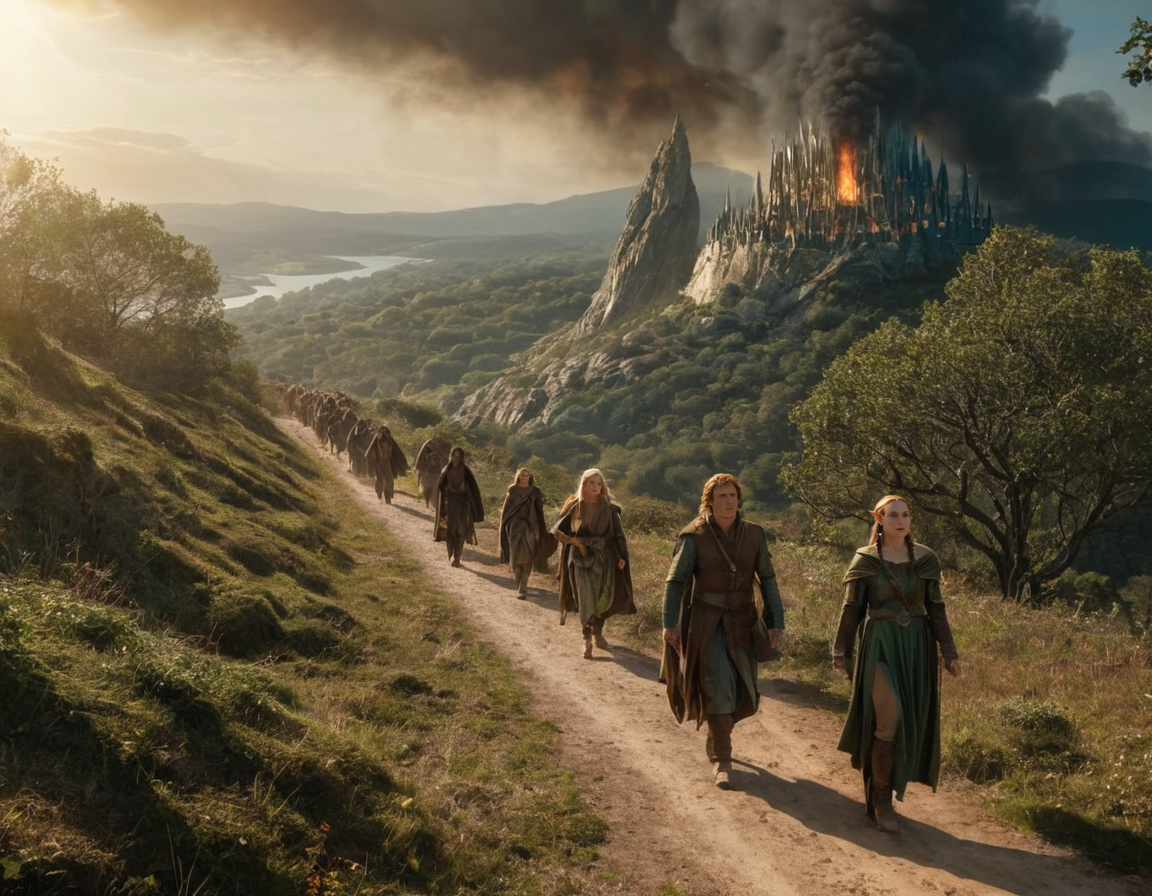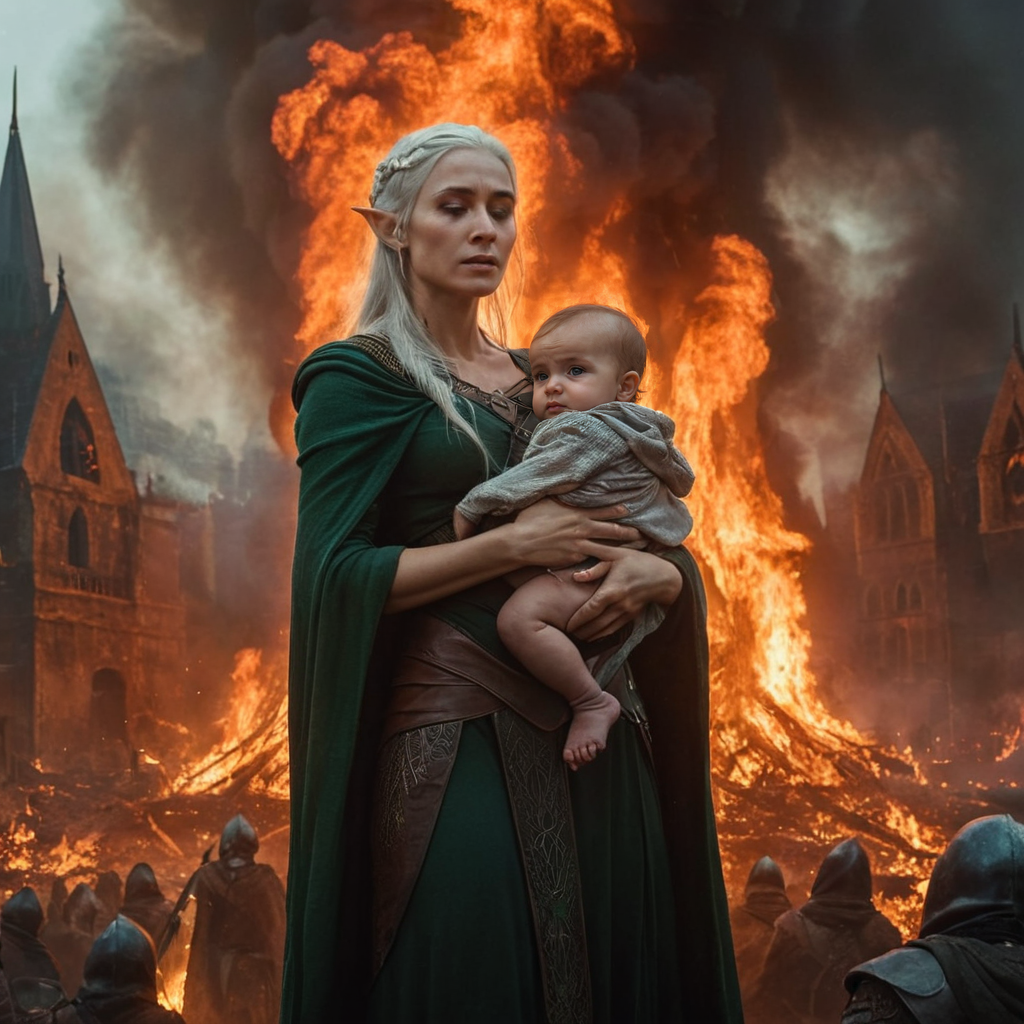The Elven Genocide
The Conflict
Prelude
"I’d hear tales around the fire of Elven lords who ripped children away from their mothers, who fed Humans scraps like dogs. My own heartbreak fueled my imagination; I pictured my mother’s final moments as she pleaded for mercy. Anger flared, and I vowed never to be powerless again. Soon enough, they pressed a bow into my hands, guiding me to release an arrow. It felt strangely exhilarating to finally hold an instrument of vengeance." - Account of Verdan, Alerian Rebel For centuries, Elven kingdoms such as Halentha and Lorintha maintained rigid social orders that consigned countless Humans to servitude. Under the Elves’ sleek architecture and refined courtesies lurked a harsh reality: Human slaves toiled in the fields, mines, and households of their Elven masters, often denied basic dignity or hope for emancipation. Each generation grew more resentful as they labored under abbhorent conditions and oppressive oversight, whispers of hatred smoldering like hidden embers. The situation reached a breaking point with the emergence of Alerio, a slave once exiled from Silvertower for daring to peruse banned texts. Driven by a vision of a future free from Elven tyranny, Alerio rallied fellow slaves and outcasts in the Western Colonies, forging alliances with Dwarves who also chafed under Elven influence. As Alerio’s warband liberated worksites and small towns across Holz, he rapidly transcended his role as a simple rebel leader. Among desperate Humans, his actions and uncanny resolve took on a quasi-religious aura, as though he were an avatar of their collective suffering. Stories circulated of his bravery and supposed divine favor, compelling an ever-growing band of followers to swell the Human ranks with fervent zeal. When The Human Rebellion formally ignited, it was not only a war of liberation but also a movement infused with near-fanatical conviction. Bolstered by Alerio’s stirring speeches, rebel detachments saw themselves as avenging angels of a long-oppressed people, with each victory against Elven forces reinforcing the belief that the Elves’ downfall was not just strategic but righteous. As resentment gave way to hatred and hatred to zealotry, the stage was set for violence of unimaginable scale.
Outcome
Aftermath
Historical Significance
"At dusk, a group of us found a cellar where Elven survivors were huddled. One of our dwarven archers raised his crossbow, but I stepped between him and the cowering figures. For a fleeting moment, I tried to muster the conscience to defy the mission. Then a human commander stepped in, barking that we had no right to withhold his spoils. He shoved me aside, signaled his men, and sealed the fate of those within. I stayed silent. My oath was to gold, after all." - Account of Grelan Stonefist, a Dwarven Mercenary contracted by Alerian Rebels The Elven Genocide emerged in the turbulent aftermath of the Human Rebellion and intensified immediately following the Devastation of Skyreach, an event that decapitated the fledgling Imperial League and left the region fractured. In the early years of the Imperial Era, radical Human commanders, emboldened by their victory against Elven kingdoms, fueled the violence. Joined by Dwarven mercenary companies that had already proven pivotal in the rebellion, these factions redirected their initial cause of liberation into a campaign of extermination aimed at purging the Elven race. While the broader Human movement had once rallied around Alerio as a symbol of emancipation, a fanatical element within the rebellion began to twist that reverence into hatred for all things Elven. Leaders promulgated the notion that preserving and honoring Alerio’s memory required eradicating perceived Elven corruption. Encouraged by this fervor, many rebel detachments razed Elven settlements and embarked on forced marches that uprooted entire populations. In the months following the Devastation of Skyreach, the fanaticism surrounding Alerio’s cult of personality assumed a more organized form. As power struggles raged among the Imperial League’s successor states, militant devotees seized the opportunity to target Elven enclaves, citing a holy mandate to avenge Alerio’s death. These purges were particularly brutal in regions already devastated by war, such as the Velvet Coast, where broken Elven city-states and defenseless refugees became easy targets. Towns like Thaloris fell to a systematic onslaught that saw thousands killed or forced to flee. It was during this intense wave of violence that rumors spread of a newly emerging Order of Alerio, an organisation that would eventually declare itself dedicated to safeguarding Alerio’s legacy. In its earliest manifestations, the movement provided the ideological framework for ongoing raids and desecrations of Elven holy sites. Pilgrims who identified as Alerio’s most zealous followers sailed to the Isle of Lorinth, purportedly to obliterate shrines dedicated to the Elven goddess Lorinth. None among them returned, and tales of their disappearance became the source of lingering dread, hinting at unknown forces or silent protectors still guarding Elven sanctuaries. By 12 IE, the genocide had largely completed its destructive course across Orienta. Elven survivors fled or were forcibly driven from their ancestral homelands, leaving the once flourishing tapestry of Elven culture in ruins. Little time was allowed to the fledgling Imperial League to reflect on the horrors they had imparted in the name of liberation before The North was once again consumed by the fires of war with The Devastation of Skyreach and commencement of the Imperial Civil War.Legacy
In Literature
Elven Works
"The Elven Genocides: Scenes from the Tragedy"Author: Hortensia Isilda
Institution: The Siar Conclave, Free City of Cymara
This three part series explores the tragedies and misery of the Elven Genocides as experienced by its survivors and victims, examining the background, events, and outcomes in a narrative style. The author shines a particular lens on the perspective of the common Elf, emphasising the fear and horror of its most vulnerable victims, before examining the barbarity from a macro perspective and detailing considerations for the prevention of similar future potential repeats of the tragedy."
Human Works
“Chains Forged by Crowns: A Socio-Political Reflection on the Post-War Elven Population Crisis”Author(s): Aurelius Hasin & Solana D’Avoire
Institution: The Scholum Argentum, The Silvertower Republic
This widely cited treatise frames the genocide as the inevitable outcome of centuries-long Elven dominion. While condemning the mass atrocities, it stresses the role of deep-rooted grievances—particularly the enslavement of Humans—in igniting large-scale retributive violence. Incorporating oral histories, archival remnants, and anthropological data, the authors argue that any investigation of the genocide must balance moral outrage with an understanding of the political forces at play.
“Alerio’s Holy Mandate: The Righteous Cleansing of Elven Dominion”
Author: Inquisitor Callistan Varo
Institution: Order of Alerio, Fortis Isle
In this inflammatory tract, Inquisitor Callistan Varo of the Order of Alerio offers an unapologetic defense of the Elven Genocide, framing it as a sacred duty predestined by the prophecy of Alerio’s eventual rebirth. Varo’s central thesis contends that Elves, having long subjugated humanity through slavery and cultural tyranny, stood as the final obstacle to Alerio’s divine legacy. By citing passages from the Order’s earliest liturgical scrolls—particularly those detailing Alerio’s adversities under Elven rule—Varo concludes that the widespread slaughter of Elven populations was not only warranted but preordained.
Dwarven Works
“From Ashes to Silence: Dwarven Perspectives on the Elven Genocide”Author: Ardain Stonebeard
Institution: Archive of Dwarven Knowledge, Khel Doran
This specialized monograph compiles rare documents and oral testimonies from Dwarven mercenaries who participated in the genocide. Stonebeard aims to reconcile heroic ballads celebrating Dwarven martial prowess with the realities of ethnic violence. While the work refrains from direct moral judgment, it carefully details how mercenary contracts, economic pressures, and longstanding animosities facilitated dwarven involvement.
Collaborative Works
"Cycles of Violence: An Examination of the Elven Genocides as an Outcome of Broader Historical and Socio-Political Contexts"Author(s): WITHELD
Institution(s): WITHELD
In this landmark collaboration between several high-profile academics, authors, independent organisations, and institutions, this series examines the totality of the Elven Genocides as a function of its geopolitical and historical context. In particular, this series will examine the actions of the Elven Empires prior to the genocide, contemporary Alerian political developments, concurrent and historical Dwarven foreign policy, the actions and interventions of third parties and otherwise neutral states and organisations, and the outcomes as pertains to the policies and actions of modern-day state and non-state actors.




Comments